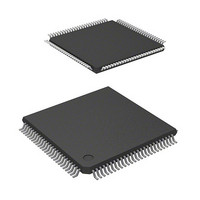DF2110BVTE10 Renesas Electronics America, DF2110BVTE10 Datasheet - Page 341

DF2110BVTE10
Manufacturer Part Number
DF2110BVTE10
Description
MCU 3V 64K 100-TQFP
Manufacturer
Renesas Electronics America
Series
H8® H8S/2100r
Datasheet
1.DF2110BVTE10V.pdf
(561 pages)
Specifications of DF2110BVTE10
Core Processor
H8S/2000
Core Size
16-Bit
Speed
10MHz
Connectivity
Host Interface (LPC), I²C, SCI
Peripherals
POR, PWM, WDT
Number Of I /o
82
Program Memory Size
64KB (64K x 8)
Program Memory Type
FLASH
Ram Size
2K x 8
Voltage - Supply (vcc/vdd)
3 V ~ 3.6 V
Oscillator Type
External
Operating Temperature
-20°C ~ 75°C
Package / Case
100-TQFP, 100-VQFP
Lead Free Status / RoHS Status
Contains lead / RoHS non-compliant
Eeprom Size
-
Data Converters
-
Other names
HD64F2110BVTE10
HD64F2110BVTE10
HD64F2110BVTE10
Available stocks
Company
Part Number
Manufacturer
Quantity
Price
Company:
Part Number:
DF2110BVTE10V
Manufacturer:
Renesas Electronics America
Quantity:
10 000
- Current page: 341 of 561
- Download datasheet (4Mb)
The transmission procedure and operations by which data is sequentially transmitted in
synchronization with ICDR (ICDRT) write operations, are described below.
1. Initialize the IIC as described in section 13.4.2, Initialization.
2. Read the BBSY flag in ICCR to confirm that the bus is free.
3. Set bits MST and TRS to 1 in ICCR to select master transmit mode.
4. Write 1 to BBSY and 0 to SCP in ICCR. This changes SDA from high to low when SCL is
5. Then the IRIC and IRTR flags are set to 1. If the IEIC bit in ICCR has been set to 1, an
6. Write the data (slave address + R/W) to ICDR.
7. When one frame of data has been transmitted, the IRIC flag is set to 1 at the rise of the 9th
8. Read the ACKB bit in ICSR to confirm that ACKB is cleared to 0. When the slave device has
9. Write the transmit data to ICDR.
10. When one frame of data has been transmitted, the IRIC flag is set to 1 at the rise of the 9th
11. Read the ACKB bit in ICSR.
high, and generates the start condition.
interrupt request is sent to the CPU.
With the I
data following the start condition indicates the 7-bit slave address and transmit/receive
direction (R/W).
To determine the end of the transfer, the IRIC flag is cleared to 0. After writing to ICDR, clear
IRIC continuously so no other interrupt handling routine is executed. If the time for
transmission of one frame of data has passed before the IRIC clearing, the end of transmission
cannot be determined. The master device sequentially sends the transmission clock and the
data written to ICDR. The selected slave device (i.e. the slave device with the matching slave
address) drives SDA low at the 9th transmit clock pulse and returns an acknowledge signal.
transmit clock pulse. After one frame has been transmitted, SCL is automatically fixed low in
synchronization with the internal clock until the next transmit data is written.
not acknowledged (ACKB bit is 1), operate step [12] to end transmission, and retry the
transmit operation.
As indicating the end of the transfer, the IRIC flag is cleared to 0. Perform the ICDR write and
the IRIC flag clearing sequentially, just as in step [6]. Transmission of the next frame is
performed in synchronization with the internal clock.
transmit clock pulse. After one frame has been transmitted, SCL is automatically fixed low in
synchronization with the internal clock until the next transmit data is written.
Confirm that the slave device has been acknowledged (ACKB bit is 0). When there is still data
to be transmitted, go to step [9] to continue the next transmission operation. When the slave
device has not acknowledged (ACKB bit is set to 1), operate step [12] to end transmission.
2
C bus format (when the FS bit in SAR or the FSX bit in SARX is 0), the first frame
Rev. 2.00 Mar 21, 2006 page 301 of 518
Section 13 I
2
C Bus Interface (IIC)
REJ09B0299-0200
Related parts for DF2110BVTE10
Image
Part Number
Description
Manufacturer
Datasheet
Request
R

Part Number:
Description:
KIT STARTER FOR M16C/29
Manufacturer:
Renesas Electronics America
Datasheet:

Part Number:
Description:
KIT STARTER FOR R8C/2D
Manufacturer:
Renesas Electronics America
Datasheet:

Part Number:
Description:
R0K33062P STARTER KIT
Manufacturer:
Renesas Electronics America
Datasheet:

Part Number:
Description:
KIT STARTER FOR R8C/23 E8A
Manufacturer:
Renesas Electronics America
Datasheet:

Part Number:
Description:
KIT STARTER FOR R8C/25
Manufacturer:
Renesas Electronics America
Datasheet:

Part Number:
Description:
KIT STARTER H8S2456 SHARPE DSPLY
Manufacturer:
Renesas Electronics America
Datasheet:

Part Number:
Description:
KIT STARTER FOR R8C38C
Manufacturer:
Renesas Electronics America
Datasheet:

Part Number:
Description:
KIT STARTER FOR R8C35C
Manufacturer:
Renesas Electronics America
Datasheet:

Part Number:
Description:
KIT STARTER FOR R8CL3AC+LCD APPS
Manufacturer:
Renesas Electronics America
Datasheet:

Part Number:
Description:
KIT STARTER FOR RX610
Manufacturer:
Renesas Electronics America
Datasheet:

Part Number:
Description:
KIT STARTER FOR R32C/118
Manufacturer:
Renesas Electronics America
Datasheet:

Part Number:
Description:
KIT DEV RSK-R8C/26-29
Manufacturer:
Renesas Electronics America
Datasheet:

Part Number:
Description:
KIT STARTER FOR SH7124
Manufacturer:
Renesas Electronics America
Datasheet:

Part Number:
Description:
KIT STARTER FOR H8SX/1622
Manufacturer:
Renesas Electronics America
Datasheet:

Part Number:
Description:
KIT DEV FOR SH7203
Manufacturer:
Renesas Electronics America
Datasheet:











